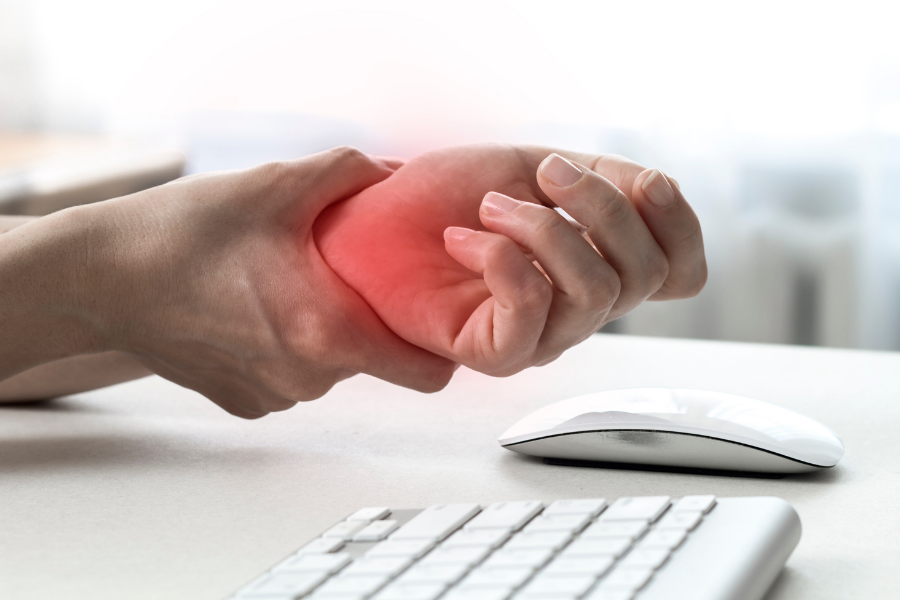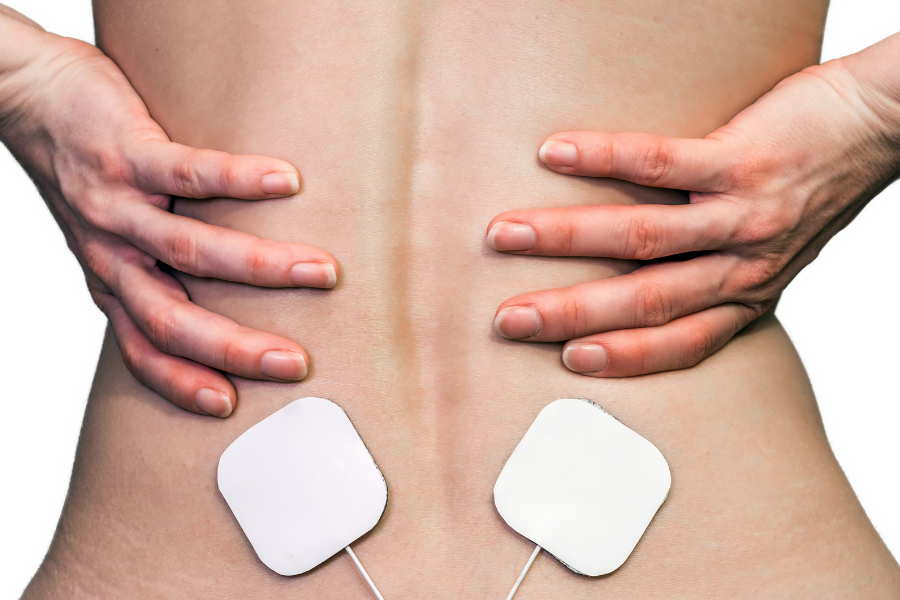Complex regional pain syndrome, or CRPS, is a collection of symptoms occurring in one area of the body usually after a prior injury. The pain is chronic (lasting longer than six months) and is generally caused by a malfunction of the nerves in the area, or possibly, a problem with pain signals firing when they shouldn’t due to extensive damage to both the tissue as well as the nervous system in the given area. CRPS usually affects limbs and is divided into two types: CRPS I and CRPS II.
CRPS I is characterized by chronic pain after an injury without confirmed nerve damage and CRPS II is chronic pain with confirmed nerve injury.
Because CRPS is a syndrome, it’s characterized as a collection of related symptoms pointing towards a possible cause, and as such varies wildly in terms of severity, duration, and treatment. In some cases, CRPS can go away on its own, but more often it persists and becomes a lifelong condition.
There is no one-size-fits-all solution for complex regional pain syndrome as the cause and effect relationship between nerve damage, tissue damage, and chronic pain is not fully understood. However, treatments typically focus on managing the pain and improving function. This can include medications, physical therapy, and implanted devices such as spinal cord stimulators.
What Causes Complex Regional Pain Syndrome (CRPS)?
In general, we don’t completely understand why CRPS develops after some injuries, and not after others. The level of trauma endured by a person does not necessarily seem to correlate with the incidence of CRPS. Neither does the type of injury. Most cases of CRPS occur after:
- Burns and lacerations
- Bone fractures
- Sprains, strains, tendon tears
- Surgery
- Limb immobilization (having an arm or leg stuck under something or placed in a cast)
In cases of CRPS with confirmed nerve damage, it’s generally understood that the damage to the nerves itself is what is causing the chronic pain. Failure on the body’s part to heal properly may have led to nerves continuing to misfire and send out pain signals long after an injury or post-operative wound has completely healed. In particular, it may be the smaller unmyelinated or thinly myelinated nerves in an injury site that play a role in the development of CRPS.
In very rare cases, it’s possible for CRPS to develop without an external or traumatic injury. Rather than being caused by nerve damage, it’s understood that this form of CRPS is caused by impingement or entrapment of the nerves, an infection, or a previously undiagnosed internal injury.
These nerves communicate directly with blood vessels as well as send signals of pain to the brain – failure to properly communicate with blood vessels may lead to increased inflammation, swelling, bruising, muscle pain, and joint pain. These conditions trigger immune responses in the body, causing fever, increased levels of inflammatory chemicals, and more pain.
Genetic influences both through autoimmune diseases and forms of chronic inflammation also play a role in CRPS. More recently, there may be a possibility of CRPS itself being partially genetic.
What CRPS Looks Like
One of the difficulties surrounding CRPS is realizing that the pain is chronic, and possibly not going to go away. Recognizing that it may be CRPS early on is very difficult, but treatment works best the sooner it is diagnosed.
While acute pain after an injury or surgery is normal, it is not normal to feel pain without any injury whatsoever, nor is it normal for pain to fail to subside weeks and months after an injury has occurred. A few symptoms to help identify complex regional pain syndrome include:
- Sensitivity to touch
- Constant inflammation
- Clammy, sweaty, or cold skin
- Continuous chronic burning/throbbing
- Changes in skin color, texture, and hair and nail growth
- Muscle weakness, tremors, spasms, and muscle loss
- Loss of mobility weeks after an injury has begun healing
The symptoms differ wildly from person to person, but all involve some form of continuous or worsening pain after an injury has begun healing, despite taking every precaution to properly address the injury.
Listen to you Body
If your injury worsens because you continue to provoke it or stress the muscle/bone, then it’s likely that you’re experiencing problems because you’re moving past rehab and closer towards doing more than your body can handle and recover from.
But if you’re diligently treating your injury and continue to experience pain, swelling, and sensations beyond what your doctor and physician may consider appropriate or normal, you may be developing CRPS. This is especially true if your limb is beginning to become cold, pale, with thinning skin and hair growth, implying limited circulation and blood vessel issues.
If you’re beginning to struggle severely with moving the injury site, if touch and pressure become unbearable, and if it’s obvious that there are significant circulatory issues or inflammation in the site, it’s important to see a doctor as soon as possible.
Diagnosis of CRPS
No tests were performed by CRPS. The diagnosis is based on the person’s health status. Sometimes doctors can perform blood tests, bone scans, ultrasound scans, CT scans, or MRI scans if they suspect another condition has similar symptoms.
Most doctors don’t even understand CRPS. It might cause a delay in diagnosis or mistake in diagnosis if an individual does not have the disorder. All diagnostics must be made by a medical practitioner who knows everything about CRPS. They might be doctors, occupational therapists, or physical therapists.
Diagnosis is done through extensive testing of the injury site with x-rays, MRIs, a thorough bone scan, and nervous system tests. Bone scans will reveal if any abnormal changes occurred in the bone during healing. X-rays will reveal if your bones have become porous or less dense over time.
MRIs can capture a wide variety of tissue changes and scarring, while sympathetic nervous system tests look for and measure the temperature, blood flow, and sweat production of a given area, to see how well the sympathetic nervous system reacts, and whether there is any delay or problems. Once the doctor is sure you’re struggling with CRPS, it’s time to find the best course of treatment for your condition.
How is CRPS treated?
Almost all mild cases recover completely. Treatment works best when taken early. The most widespread therapies are rehabilitation and physiotherapy. The following are: It’s one of the best treatments available to CRPS. The movement of painful joints or muscles increases circulation and decreases circulation symptoms while maintaining flexibility and strength. Rehabilitated leg assists in reversing or eliminating secondary spinal nerve and brain changes associated with disuse and chronic pain. Occupational therapy can be an effective means of rehabilitating, aging, and gaining active life skills. Psychotherapy.
Figuring Out a Treatment Plan
The best approach is a multimodal approach that combines a number of effective therapies and treatments. The goal is to find the right combination that combats the symptoms of the syndrome and increases the quality of life.
Heat and cold therapy, topical painkillers, nerve, and spinal cord stimulation as well as corticosteroid injections, and nerve blocks can help reduce pain, massively reduce inflammation, help make the site more tolerable, and give a patient some relief.
Medication can help as well, including over-the-counter painkillers such as NSAIDs and acetaminophen, and certain non-addictive prescription drugs including antidepressants and anticonvulsants.
Physical therapy is important both for treatment and prevention. Helping a patient get moving and slowly introducing exercise into the patient’s life can improve circulation. It can also slow muscle atrophy, bone density loss, and help relieve pain through the natural release of endorphins. Low-impact exercise, such as swimming, walking underwater, or utilizing an elliptical machine is preferable. Hard running, jogging on a treadmill/concrete, or heavy weightlifting is not recommended.
The longterm outlook for CRPS
Most people recovering from CRPS experience symptoms varying from mild to severe. For fewer individuals with CRPS, pain continues to be severe. Around 1 in 3 CRPS cases have been reported in people with symptoms.
Child relapses are higher among children than adults. A relapse can arise in any given case without knowing it; a reaction or a different problem can arise. Recent research suggests recurrent relapse can be prevented by using pain killers when surgery is performed.
In the long term, CRPS is managed by working on ways to effectively kill the pain and reduce inflammation. There are no straightforward cures for CRPS, and treatment depends entirely on what a patient responds to the most.
Aside from the aforementioned treatments, some up-and-coming treatments include ketamine infusion, relaxation techniques (such as biofeedback), and the use of long-term painkilling options such as intrathecal pain pumps.
What research is being done on CRPS?
NINDS seeks fundamental knowledge about brains and nerves and utilizes this knowledge to reduce neurologic disease burdens. NINDS is a division within NIH the world’s largest supporter of biomedicine research and is responsible for NIH’s CRPS project. It provides support to help reduce opioid addiction long term by implementing innovative technologies. In this initiative, NIHS supports NIH’s efforts in improving patient care for opioid use and addiction.
CRPS is a complex regional pain syndrome that can be difficult to diagnose and treat. However, with the help of a doctor, patients can find relief from their symptoms through a variety of treatments. If you or someone you know is struggling with CRPS, don’t hesitate to reach out for help.
There are many resources available, and there is no one-size-fits-all approach to treatment. Find the therapies and treatments that work best for you and stick with them.
Conclusion
CRPS is a complex regional pain syndrome that can be difficult to diagnose and treat. However, with the help of a doctor, patients can find relief from their symptoms through a variety of treatments. If you or someone you know is struggling with CRPS, don’t hesitate to reach out for help. There are many resources available, and there is no one-size-fits-all approach to treatment. The best thing you can do is find the therapies and treatments that work best for you and stick with them.
Take the First Step Towards Pain-Free Living Today




